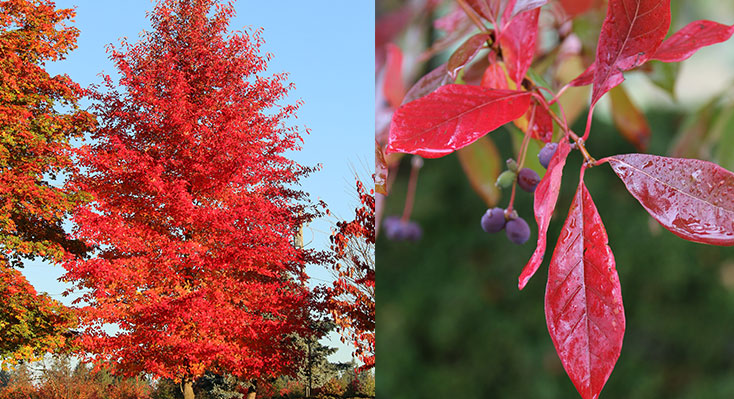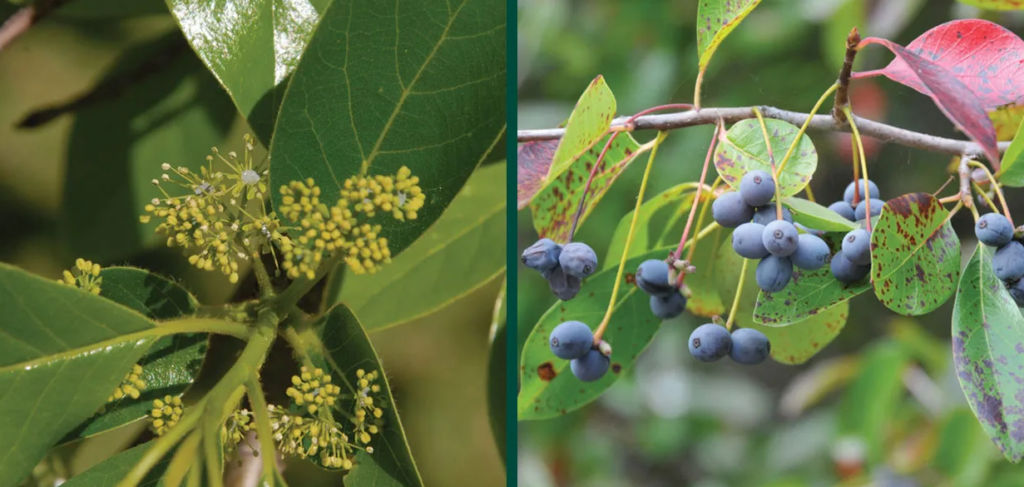
The black tupelo tree, scientifically known as Nyssa sylvatica, is a deciduous tree native to eastern North America from the coastal Northeastern United States and southern Ontario south to central Florida and eastern Texas, as well as Mexico. This tree has a has a rich history and also referred to by names, such as black gum, sour gum, or pepperidge tree. The name “tupelo” is of Native American origin, coming from the Creek words “ito” meaning “tree” and “opilwa” meaning “swamp.”
Native American tribes valued the black tupelo for its various uses. The inner bark was used for weaving baskets, while the leaves provided a natural dye. Some evidence suggests they might have used other parts for medicinal purposes as well. Black tupelos have always being used in wetland ecosystems. Their ability to thrive in swampy areas helps stabilize shorelines and prevent soil erosion. Their leaves decompose in the water, providing nutrients for aquatic life.
The black tupelo tree can thrive in a variety of habitats, from swamps and wetlands to upland forests. It prefers acidic, medium to wet, well-drained soils and full sun to part shade. It is also tolerant of urban environments, provided it is given adequate space to grow and proper care, including regular watering and protection from soil compaction.
Size
The black tupelo has a characteristic pyramidal or oblong-ovoid crown shape when young. Over time, the branches tend to become more horizontal, especially the lower ones, which can droop towards the base. Occasionally, the trunk may fork, resulting in a more irregular and open crown in mature trees.
The reach a mature height of 30 to 50 feet. In exceptional circumstances, some may grow as tall as 100 feet in the wild. The crown of a black tupelo has a matching spread to its height, ranging from 20 to 30 feet across at maturity. On average, the can be expected to grow around 13 to 24 inches in height per year. This translates to roughly about 12 to 15 feet over 10 to 15 years. In terms of lifespan, the tree is long-lived. It can reach an age of 200 to 300 years, with some specimens living even longer.
Leaves

The leaves of the black tupelo are simple, alternate, and obovate to elliptic in shape. Elliptical leaves are elongated ovals with pointed tips on both ends, while obovate leaves are similar but slightly wider at the tip than the base. The leaves are dark green in color on the upper surface and paler green on the underside. The leaves are 3 to 6 inches long and 1/2 to 3 inches wide. They have an entire margin (the edge is smooth and not serrated or toothed).
During the summer months, black tupelo leaves come alive with a dark green color. The upper surface has a glossy sheen. In the fall, the leaves turn a brilliant array of colors, including yellow, orange, red, and purple.
The leaves usually provide a valuable food source for various insects throughout the growing season. Caterpillars and other leaf-eating insects munch on the foliage.
Flowers and Fruit

The black tupelo tree flowers in the spring, after the leaves have emerged and begun to reach their full size. The exact timing of bloom can vary depending on the climate, but it typically occurs from April to June. The flowers are small with a greenish-white color, and they are not very fragrant.
The black tupelo tree is dioecious, meaning that individual trees produce either male or female flowers, but not both. This means that in order for a black tupelo tree to produce fruit, there must be both male and female trees growing in close proximity to each other. Some trees may have a few perfect flowers, with both male and female reproductive parts, but this is not common. The inconspicuous flowers are pollinated by bees, attracted by the nectar they produce.
The black tupelo fruit is a small drupe, only about 10 millimeters in diameter. It’s ovoid or oval-shaped, with a smooth, slightly oily skin that ripens to a deep black-purple color in the fall. The fruits don’t grow individually. They appear in clusters of one to three fruits hanging from a long, slender stalk that emerges from a reddish peduncle (the stalk attaching the fruit to the branch). The flesh of the fruit has a strong sourness and bitterness and not pleasant for everyone to eat raw. However, some people find the flavor interesting and enjoy using the fruit in recipes.
Bark and Trunk
Black tupelo trees have a straight trunk, especially when young. However, as they mature, the branches can become stout and many-branched, The trunk usually develops a long, clean shaft above its buttressed base, especially in a forest stand.
On young trees, the bark is a smooth gray or brown. However, on mature trees, Deep furrows develop over time, breaking the bark into thick, blocky plates that resemble alligator hide . These plates can be several inches thick and project outwards from the trunk. The surface layers of the bark, particularly on the exposed sides of the tree, often break off due to weathering, especially during freeze-thaw cycles in winter.
The branches of the black tupelo tree come out at right angles to the trunk and either extend horizontally or droop slightly, giving the tree a long, narrow, cone-like head. The bark on the branches is similar to that on the trunk.
The bark on the trunk is often described as having a “cobbled” appearance, with deep ridges that create rectangular or square patterns. This unique bark texture is one of the distinguishing characteristics of the black tupelo tree.
Root System
The black tupelo tree develops a taproot system (has a main root that grows straight down into the soil0. This taproot anchors the tree and provides stability, especially in windy conditions. The taproot can grow quite deep, reaching depths of up to 10 feet or more. This allows the tree to access water and nutrients from deep within the soil, which can be particularly beneficial during periods of drought or in soils with low nutrient levels.
The taproot also helps the tree reach deeper sources of water and nutrients. In addition to the taproot, the black tupelo tree also develops lateral roots that spread out horizontally from the base of the tree. These lateral roots help to stabilize the tree and also absorb water and nutrients from the surrounding soil. The spread of the root system can be quite extensive, with the roots extending several times the width of the tree’s canopy.
Common Problems of Growing Black Tupelo Tree
Diseases
- Leaf Spots: This is a common fungal disease that causes purplish or brown spots to appear on the leaves. While unsightly, leaf spots are usually not a major threat to the overall health of the tree. In most cases, the leaves will simply fall off naturally, and new, healthy growth will emerge the following spring.
- Cankers: These are sunken areas on the branches or trunk caused by fungal infections. Cankers can enlarge over time, potentially girdling branches and restricting nutrient flow. If cankers appear, pruning out the affected branches can help prevent further spread.
- Heart rot: Black gum trees are susceptible to heart rot fungal disease in which the heartwood and limbs decay from the inside out.
- Verticillium wilt: Caused by the verticillium fungi, this wilt attacks many plants, including black gum trees. The fungus lurks in the soil, attacking the underground portion of the tree. The disease can cause leaves to yellow or become stunted and fall from the tree too soon.
- Rust: This fungal disease can cause yellow or orange pustules to appear on the leaves. In severe cases, rust can lead to defoliation. However, rust infections on black tupelo trees are uncommon and rarely cause lasting damage.
Pests
- Leaf Miners: These are small, flying insects whose larvae tunnel within the leaves of the black tupelo. The larvae leave behind winding trails or discolored patches on the leaves, which can be unsightly but rarely cause significant damage to the overall health of the tree.
- Scale: These are sap-sucking insects that attach themselves to the leaves and stems of the black tupelo. They can cause leaves to become yellowed and drop prematurely. In severe infestations, scale can weaken the tree, but this is uncommon for black tupelo.
- Forest Tent Caterpillars: While not a specific pest to black tupelo trees, these caterpillars can occasionally defoliate them in the spring, particularly if there’s an outbreak in the area. These caterpillars feed on the leaves of many different deciduous trees.
- Aphids: Aphids are small, soft-bodied insects that can suck the sap from black tupelo trees, causing leaves to curl and wilt. They can also secrete a sticky substance called honeydew, which can attract other pests and promote the growth of sooty mold.
- Borers: Borers are insects that tunnel into the wood of black tupelo trees, causing damage to the tree’s structure. They can weaken the tree and make it more susceptible to disease and breakage.